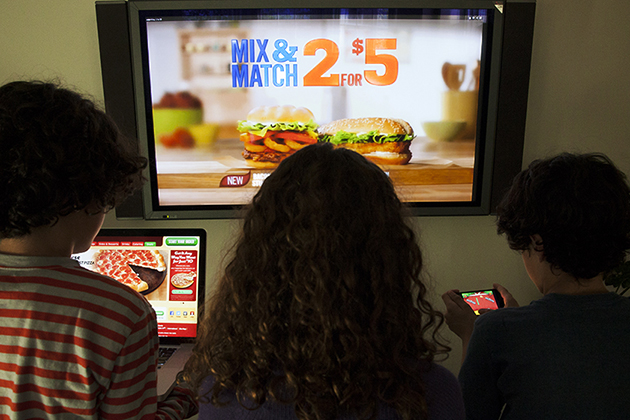
Food companies disproportionately target their TV advertising for fast food, candy, sugary drinks, and snack brands to young black and Hispanic consumers, according to a new report released by the Rudd Center for Food Policy & Obesity at the University of Connecticut, the African American Collaborative Obesity Research Network (AACORN), and Salud America!
In contrast, the report finds, these companies were significantly less likely to target black and Hispanic consumers with their TV advertising for healthier food categories, such as yogurt and other dairy products, 100 percent juice, water, and fruits and vegetables.
“Our analysis of the largest food, beverage, and restaurant corporations in the United States shows that these companies vary widely in their focus on advertising targeted to black and Hispanic youth,” says Jennifer Harris, the report’s lead author, UConn associate professor-in-residence, and the Rudd Center’s director of marketing initiatives. “Unfortunately, the majority of brands targeted to youth of color are nutritionally poor products that can be harmful to their health.”
The report, “Food advertising targeted to Hispanic and Black youth: Contributing to health disparities,” examines advertising by 26 major restaurant, food, and beverage companies in 2013. All companies with at least $100 million in advertising spending during 2013 were included the analysis, as well as companies participating in the Children’s Food and Beverage Advertising Initiative, a voluntary, self-regulatory program, as of December 2014.
To compile this comprehensive report, researchers analyzed the amount and related expenditures of TV food and beverage advertising on Spanish-language TV and black-targeted TV programming; TV advertising disproportionately viewed by black youth compared with white youth; youths’ exposure to this advertising; and the product categories and brands promoted most often. Researchers also examined the 267 most advertised brands from the 26 companies.
Unfortunately, the majority of brands targeted to youth of color are nutritionally poor products that can be harmful to their health. — Jennifer Harris
“This report highlights important disparities in the food and beverage industry’s heavy marketing of unhealthy foods to Hispanic and black youth, and the corresponding lack of promotion of healthier options,” says Amelie G. Ramirez, director of Salud America!, based at the Institute for Health Promotion Research at the University of Texas Health Science Center at San Antonio. “Given the role food marketing plays in influencing the diets of youth of color, there is increasing demand for heightened industry self-regulation and community-based action.”
The report, funded by the Robert Wood Johnson Foundation, is designed to examine targeted marketing practices and identify opportunities to encourage companies to reduce disparities in food marketing aimed at youth of color. Among the report’s recommendations are an expansion of the products and types of marketing covered by industry’s self-regulatory program, and expansion of industry’s commitment to increase the sale and availability of healthy products, which would greatly benefit black and Hispanic youth because of their heavy exposure to food and beverage advertising.
Harris presented the findings at the National Conference on Health Communication, Marketing, and Media, held Aug. 11-13 in Atlanta, Ga. The key findings include:
- Fast food and other chain restaurants spent the most on advertising in targeted media, totaling $224 million in Spanish-language TV and $61 million in black-targeted TV. Notably, Wendy’s, Olive Garden, and Burger King devoted more than 10 percent of their advertising budgets to Spanish-language TV.
- Compared with other food and beverage categories, candy, sugary drink, and snack food brands disproportionately targeted their TV advertising to black and/or Hispanic consumers.
- M&Ms, Snicker’s, Hershey’s Candy Bar, and Twix ranked in the top 10 Hispanic-targeted packaged-food brands, spending $12.8 million to $17 million on Spanish-language TV advertising. The top 10 black-targeted packaged food brands included Reese’s Peanut Butter Cups, M&Ms, Hershey’s Kisses, and Hershey’s Candy Bar, each spending more than $2 million on black-targeted TV advertising.
- Overall, black youth viewed 70 percent more food-related TV advertising compared with their white peers. In addition, they saw almost twice as many TV ads for candy, soda and other sugary drinks, and snacks.
- A total of 48 brands (18 percent of those included in the analysis) were identified as disproportionately targeting their TV advertising to children and teens compared with adults. These 48 brands were also significantly more likely to target their TV advertising to black and/or Hispanic consumers. Youth-targeted brands with the highest advertising spending on Spanish-language TV included McDonald’s, Twix Candy Bar, Cinnamon Toast Crunch Cereal, and Orbit gum. Youth-targeted brands spending at least $2.4 million on advertising on black-targeted TV included McDonald’s, Pop Tarts, Tyson Frozen Entrees, and Gatorade.
“This is a clear case of tactics that must be profitable from the business perspective but at the cost of fostering an environment that promotes poor health in black and Hispanic youth in particular,” says Shiriki Kumanyika, Chair of the African American Collaborative Obesity Research Network.
Previous research has shown that, compared with white youth, black and Hispanic youth are exposed to more food advertising in the media and more marketing messages in their communities. Rates of obesity and related diseases are higher among black and Hispanic populations, compared with whites, according to the U.S. Centers for Disease Control and Prevention.
Public health experts have raised concerns that food companies may be directly targeting black and Hispanic youth with TV advertising for nutritionally poor foods, exacerbating health disparities. The full report is available on the Rudd Center website at www.uconnruddcenter.org.



